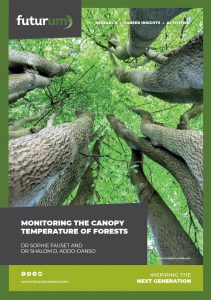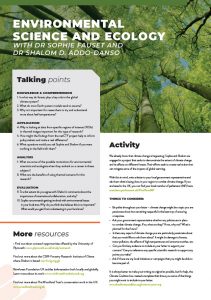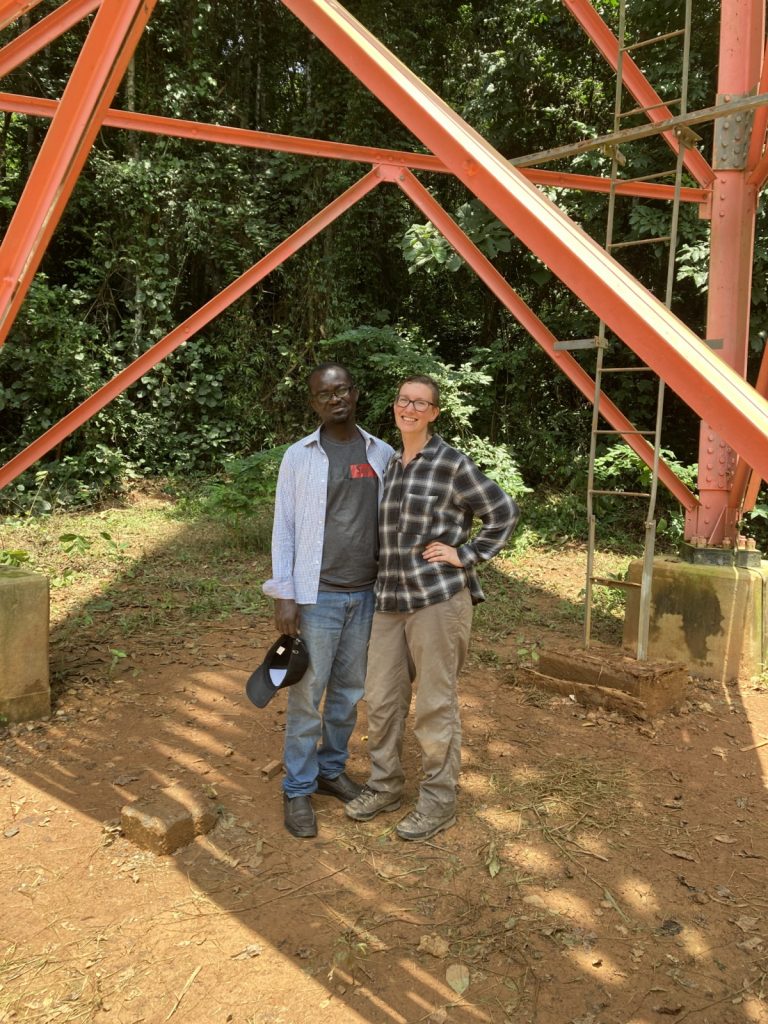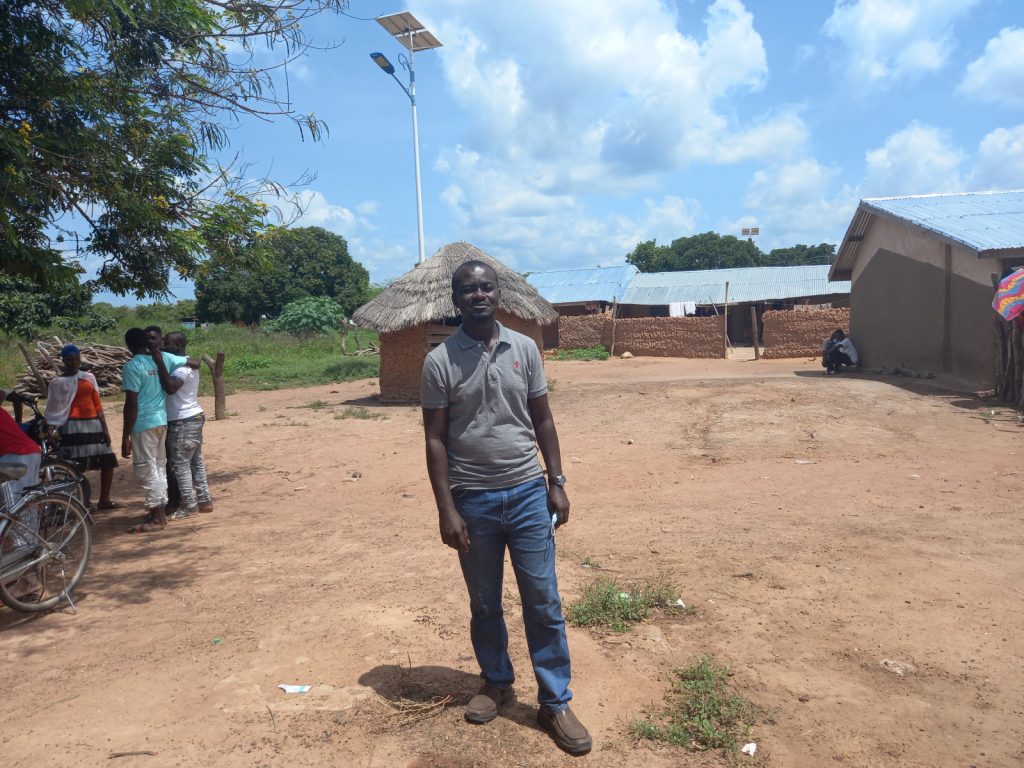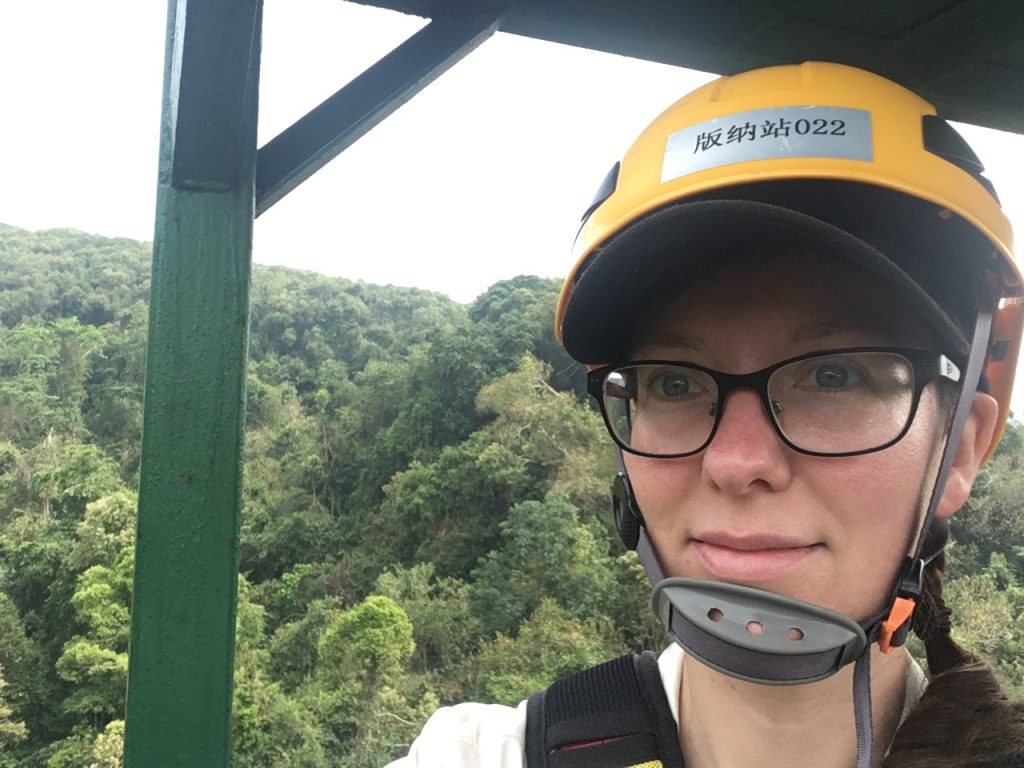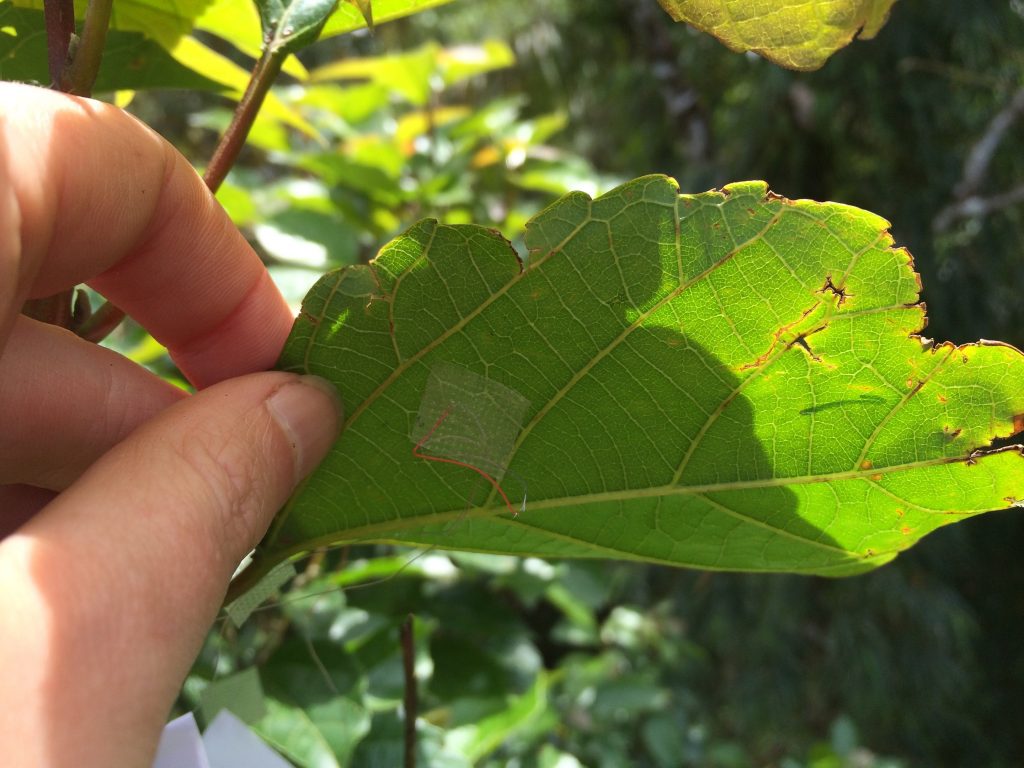Monitoring the canopy temperature of forests
Dr Sophie Fauset, from the University of Plymouth in the UK, and Dr Shalom D. Addo-Danso, of the CSIR-Forestry Research Institute of Ghana, are collaborating on a global project that seeks to monitor the canopy temperature of forests. The findings will help develop understanding of how forests are responding to climate change and, hopefully, be an impetus for action.
TALK LIKE AN ENVIRONMENTAL SCIENTIST & ECOLOGIST
Earth system model — a climate model that explicitly models the movement of carbon through the Earth system
Forest canopy — the upper layer or habitat zone, formed by mature tree crowns
Microclimate — a local set of atmospheric conditions that differ from those in the surrounding areas
Photosynthesis — the process by which green plants and certain other organisms transform light energy into chemical energy
Stomata — tiny openings or pores in plant tissue that allow for gas exchange
Forests are not only beautiful and awe-inspiring to walk around, they are also home to a substantial amount of biodiversity and play a key role in the global climate system. Forests store large amounts of carbon, and we know that increasing levels of carbon in the atmosphere have contributed to climate change. For this reason, forests are seen as a key battleground in the fight against global warming and are a key focal point for ecologists and environmental scientists.
Dr Sophie Fauset and Dr Shalom D. Addo-Danso have come together to collaborate on a project that seeks to monitor the canopy temperature of forests. Sophie is an environmental scientist based at the University of Plymouth in the UK, while Shalom is an ecologist based at the CSIR-Forestry Research Institute of Ghana in Africa. Together, they are building a new network for monitoring the canopy temperature of forests in the netCTF project.
What issues is the netCTF project attempting to solve?
Most Earth system models tend to assume that leaf temperature is the same as air temperature, but previous studies have shown this is not the case. However, many of the physiological processes that these models simulate (such as photosynthesis and respiration) are temperature sensitive, so accounting for leaf temperatures can improve model performance. “There is little data available on leaf and canopy temperatures,” explains Sophie. “We have some small-scale datasets that are collected for short time periods on individual leaves. These can provide detailed understanding of those species included but only for a short time.”
What determines leaf temperature?
There are two separate factors – the environment the leaf is in and the characteristics of the leaf itself. If conditions are sunny, the sunlight will heat the leaf above the air temperature, just like you will feel warmer if you stand in the sun. “Leaf temperature is driven by multiple factors, including conditions that exist outside the leaves and those related to the characteristics of the canopy and leaves,” says Shalom. “Some of the environmental conditions that affect leaf temperature include air temperature, atmospheric humidity, wind velocity, light intensity and atmospheric carbon dioxide.”
Understanding leaf temperature is important because it affects photosynthesis and many other critical functions and processes of plant leaves, as well as the microbial communities on leaves that influence tree growth and survival. If the leaves in forests are too hot and are unable to cool down, trees could die, further exacerbating the problems of global warming and climate change.
What methods is the team using to understand canopy temperatures?
Thermal cameras can be installed in forests to take images of canopy temperature continuously, over long periods of time. In these images, it is possible to differentiate between the tops of different trees, so researchers can look at how individual species of trees behave in terms of temperature, knowing that different species will have different leaf sizes and patterns of stomata opening and closing. The cameras can also be used to reveal mammal populations that live in the forest canopy.
These studies need to be conducted for a long period because forest systems are dynamic and the responses of forest species to global climate change are uncertain. More long-term data have to be collected by Sophie, Shalom and the team to enable them to understand how rising temperatures and other extreme weather conditions, such as drought, could impact the forests.
How will data captured by these cameras be analysed?
Once the thermal images are captured, they are processed and corrected using software. “We make a file that specifies our regions of interest (ROIs) – these are the tree canopies we want to look at. We are using a statistics and computing software
called ‘R’ to open all the images, select the data just from the ROIs, and link the temperature data to the climate data collected at the same site,” says Sophie. “In this way, we can assess patterns between different crowns and under different microclimate conditions.”
Why is it so important that these data can be shared?
While the data the team collects are extremely important to their specific research, they can be useful for scientists in other research areas. For instance, the data can be used to test how well vegetation models predict leaf temperature or show that temperature regulation is important for models to consider. “They will also be very useful for validating remotely-sensed land surface temperature data collected by satellites, such as the new NASA ECOSTRESS mission,” explains Sophie. “Making canopy temperature data available for use by others is important as it will augment existing data collections and can be used for other ecological analysis. Importantly, policymakers can use the data for decision-making on forest management,” adds Shalom.
Why is an international, collaborative approach so important?
Forests, particularly tropical forests, are important to all of us; any efforts to tackle the factors impacting these forests involve a truly international community of researchers. “The ultimate goal of the network is to provide a platform to develop, process and share data on forest canopy temperatures,” says Shalom. “A collaborative approach helps with the sharing of skills and data among many researchers and allows for outcomes that are not possible to achieve by people working individually at separate sites. It also helps us to better explain the impacts of climate change on forests with a broader global view.”
 DR SOPHIE FAUSET
DR SOPHIE FAUSET
School of Geography, Earth and Environmental Sciences, University of Plymouth, UK
Field of research: Environmental Science
DR SHALOM D. ADDO-DANSO
CSIR-Forestry Research Institute of Ghana, Kumasi, Ashanti Region, Ghana
Field of research: Ecology
Joint research project: netCTF project – developing a global network for monitoring canopy temperature of forests
Funders: Natural Environment Research Council (NERC), Global Challenges Research Fund
Reference
https://doi.org/10.33424/FUTURUM317
© Sophie Fauset
© Sophie Fauset
© Shalom D. Addo-Danso
© Sophie Fauset
© Sophie Fauset
ABOUT ENVIRONMENTAL SCIENCE
Environmental science is an interdisciplinary field which seeks to find effective means of understanding and managing the world in which we live. In particular, environmental scientists incorporate social science subjects to provide understanding relating to human relationships, perceptions and policies towards the environment.
Given the evidence regarding how human activity is impacting the climate of countries around the world, there has arguably never been a more important time to be an environmental scientist, if only so more evidence can be gathered that encourages remedying strategies to be developed.
Sophie acknowledges how challenging the field of environmental science can be but is keen to point out how much she enjoys her work. “It is exciting for me that my research helps us to understand the natural world and the impacts of climate change,” explains Sophie. “It also provides a lot of opportunity to travel and work with people from other parts of the world, and I love passing on my passion for plants to students!”
At the moment, there is a huge emphasis on restoring forest cover to help mitigate climate change and biodiversity loss. Sophie tells us that she believes there will be lots of opportunities in this area in the future.
Pathway from school to environmental science
After studying science at school, it is important for students interested in environmental science to take a science subject at college. You should also consider taking maths at a higher level as there is often a lot of number crunching to do. Sophie says that communication is important too, so she recommends doing a subject that involves writing, such as history or English.
Prospects has detailed information about studying environmental science at university and at post-graduate level: www.prospects.ac.uk/careers-advice/what-can-i-do-with-my-degree/environmental-science
Explore careers in environmental science
• Sophie recommends getting involved with environmental issues in your local area to gain experience, such as by volunteering with local environmental groups.
• In the UK, the Institution of Environmental Sciences (www.the-ies.org) or the Chartered Institute of Ecology and Environmental Management (www.cieem.net) offer free student memberships and careers advice.
• According to Indeed.com, the average salary for an environmental scientist in the UK is £31,000 per year:
uk.indeed.com/career/environmental-scientist/salaries
How did Sophie become an environmental scientist?
I was always interested in science and nature as a child and loved reading books. At different ages, my thoughts on what I wanted to be when I grew up ranged from vet to doctor to marine biologist, but I am happy with where I have ended up.
I always enjoyed science at school, and my dad was a chemistry teacher. He would spend a lot of time talking about science with me, although chemistry wasn’t my strong point! My parents were always happy for me to pursue what interested me and have been a great support throughout my career. It is a bit of a cliché, but David Attenborough’s natural history documentaries are definitely part of why I study the natural environment today.
I have found myself studying different areas of forest science since working on my PhD. I started out working on forest ecology with very low-tech equipment – mostly a tape measure! Following that, I saw that many jobs were asking for experience in either geographic information systems or modelling. Because of this, I took a research job working on model simulations of forests. This made me more interested in the physiological processes happening in the forest, and now I combine forest ecology with more in-depth studies of physiology and microclimate. I think working with different methods provides a broader view of your subject area. Programming is a key skill that I have learnt to manage and analyse data. This is really important for working with large or complex datasets.
I really enjoy getting outside and into nature. I cycle to work and am lucky that my route goes along a wooded estuary, so I get a good chance to de-stress and reflect on my day on my way home. I also spend time in my garden, which we are making more ‘nature friendly’ – it is very rewarding to see wildlife coming into the garden and feeling I am actively improving the local habitat.
My proudest career achievement is publishing my first scientific paper back in 2012. Publishing always feels great as it is recognition that you are working to the highest scientific standards. For the future, I hope to get more research funding to continue our canopy monitoring work.
Sophie’s top tips
1. My advice is to follow your passion. I think it is much easier to be motivated when you are working towards something you are excited about.
2. Keep going, even when things are hard. Often, if you are completing a research project, there are obstacles, and you have to persevere to overcome them.
ABOUT ECOLOGY
Ecologists work to find ways of protecting and restoring the natural environment. They do this by collating and disseminating important information about the impacts that human activity has on individual species and ecosystems. Ecologists like Shalom are working hard to reverse human impact and make positive changes to the world.
Shalom says the most rewarding aspect of his work is the ability to generate knowledge and information on climate change. “My research activities focus on pressing issues in ecology that can be used to enact change in policies that have practical benefits to ecosystems and people at local, national and international levels,” he explains. “I like to explore new places and interact with people, and my research activities have provided me with many travelling opportunities to explore and learn.”
There will be opportunities for ecologists around the world, but, in Africa, very few scientists are engaged in the field, so the continent is ripe for the next generation. “There are many unresolved questions surrounding important global issues including climate change, biodiversity conservation, plant-soil interactions, land use change and many more that need further probing,” says Shalom. “Forests will continue to intrigue researchers because we know so little about them.”
Explore careers in ecology
• Conservation Careers provides lots of useful information on careers in ecology.
• The Ecological Society of America and the International Union of Forest Research Organisations are also excellent resources for budding ecologists.
• According to Prospects, the salary for an assistant ecologist role is in the region of £18,000 to £22,000, depending on experience, while senior ecologists can earn between £30,000 and £45,000.
Pathway from school to ecology
Anybody interested in ecology will need to have the basics in biology, chemistry, physics and mathematics. Apart from these, the global challenges we face are complex and interconnected with different aspects of society, so students should focus on courses that are interdisciplinary in nature, including geography and communication.
A degree in a biological science or environmental subject is generally required.
How did Shalom become an ecologist?
As a youngster, I was interested in many things including writing and science. I loved asking questions about how to help people, and how things worked in nature. I also loved writing poems and short stories.
I was inspired to become a scientist by my inner passion to see changes in people’s lives. I always told my teachers I wanted to be a scientist and teach in a university, although I was not sure about the specific area of interest. I began to love nature and was intrigued by how natural systems function.
I cannot mention one particular moment that shaped my career path. However, the interactions with my PhD supervisors, especially Professor Cindy E. Prescott, helped shape my perspective about research and, eventually, some of the interests I am pursuing now. I think I have developed my communication skills, which are important for scientists to effectively communicate our findings, especially to non-technical audiences.
I am an optimist and I believe everything is possible, if only I can commit myself to it. So, in times of challenges, I draw on that belief to take me through.
I have a few standout career achievements. One is collaborating with Sophie to build the tower for the canopy temperature study. This set up is the first of its kind in Africa to monitor forests, and the tower is an important infrastructure that can advance studies in different aspects of climate change, such as measuring gas exchanges from forests to the atmosphere. My ambition is to become one of the leading ecologists in the world and help train the next generation of ecologists from Africa.
Shalom’s top tips
1. Be committed to whatever you find yourself doing.
2. Find mentors who can guide and help you grow your skills and leadership qualities.
Do you have a question for Sophie and Shalom?
Write it in the comments box below and Sophie and Shalom will get back to you. (Remember, researchers are very busy people, so you may have to wait a few days.)

